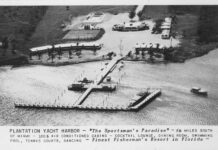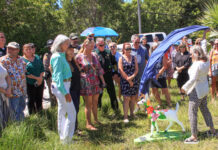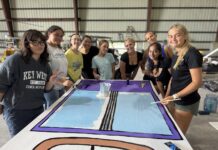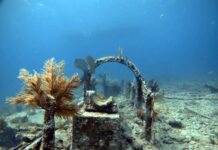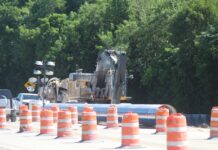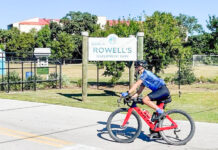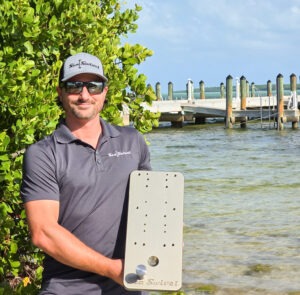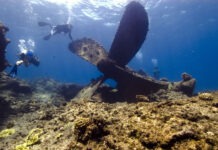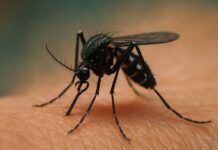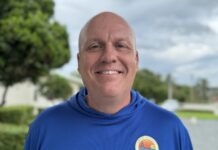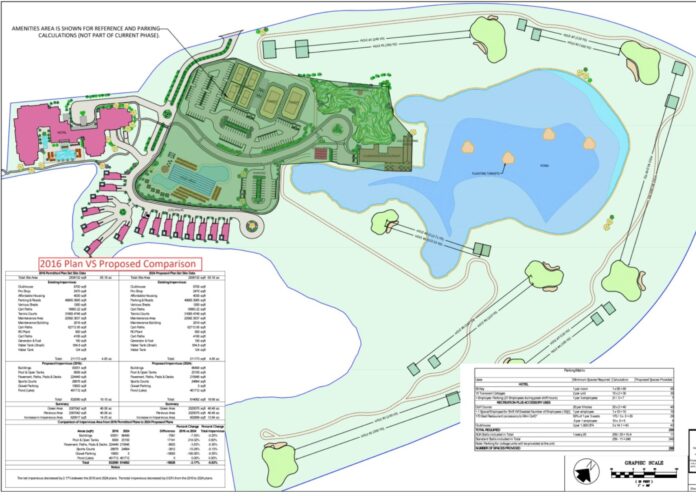
The upcoming Florida Keys Resort, due to supplant the existing Florida Keys Country Club and a golf course left half-vacant for nearly seven years, has a vision of amenities that co-owner Peter Rosasco says could be a premier attraction in the Middle Keys. But in recent weeks, the development has answered a growing list of city and state sanctions, placing it under an even closer microscope for locals.
Heavily scrutinized as the center of a debated hotel/motel redevelopment ordinance in March, and again in June as it faced resident ire over flooding on the neighboring Sombrero Boulevard, the resort’s current plans feature a 95-key hotel along with 15 three-bedroom villas. Set for construction on the existing property’s eastern end are an Olympic-size swimming pool, tennis and pickleball courts, two miniature golf courses including a “PopStroke” version designed by Tiger Woods, a clubhouse/restaurant and an aquatic driving range allowing targeted hits into the property’s on-site lagoon. Renovation of the remaining space will once again provide an 18-hole course on the property.
“Everything we’re talking about here is going to be open to the public,” Rosasco told the Weekly in an extensive sit-down on July 1. “This will be a place where people can go, even in the evening. We’re building a total recreational amenity here that’s golf-centered, but also with a pool.”
Access to the resort’s amenities for non-guests, Rosasco said, will likely take place through a tiered membership system. He added that he isn’t “trying to build something that’s exclusive to the point where it’s not available and open to the community.”
In March, Marathon councilman Kenny Matlock and residents skeptical of the development challenged the resort’s promise to maintain a full 18-hole golf course. They called the property “a gift to the community,” referring back to the original course’s low-priced sale from Stanley Switlik to the former Sombrero Country Club Inc. before its eventual acquisition by Rosasco and development company Index Investment Group.
Critics called for guarantees that the golf course would be finished alongside the lodging and other amenities, with some implying that land for the golf course would be eventually sold off in favor of a sole focus on the resort’s other features. At that time, City Attorney Steve Williams said the city could ensure the course’s construction by withholding Certificates of Occupancy for the resort’s hotel and villas until all elements were completed.
“Most people don’t seem to even care if I build the hotel or villas – they just want the golf, so the golf is going in,” said Rosasco when asked Monday if he remained committed to completing the course. “I don’t want to build a luxury upscale resort and then have a big construction project going on over there on the golf course.”
Current and accurate development plans for the property remain unclear, as each rendering of the site provided to the Weekly by Rosasco, city officials and concerned residents has contained significant discrepancies.
Rosasco confirmed that he had previously discussed selling the site’s golf operations, including design and oversight of the remodeled course, with local businessman and current Marathon City Council candidate Mike Leonard. But both Rosasco and Leonard told the Weekly that those talks were no longer “in active conversation.”
“(Selling the property) doesn’t work for me,” Rosasco said. “I would consider leasing the golf operations, but I would still own it.”
Plans currently on file with the city of Marathon include only six holes of golf in the area formerly known as the course’s “front nine,” which Rosasco said would be addressed by adding three holes to the existing course’s western “back nine.”
Acknowledging that fitting a full 18-hole course into the available area may require shorter holes or the use of multiple tee boxes, Rosasco said he felt the addition of other amenities would make up for any loss of golf space.
“I realize there are a handful of avid golfers who think this is the end of the world if it doesn’t get built to their specifications,” he said. “But I will also tell you that if most people showed up and I showed them all these nice recreational amenities, an upscale restaurant, a spa and things like that, they would say ‘Oh yeah, I’d use that.’”
Discussions in March’s city council workshop and further questions to city officials by the Weekly still point to a playable golf course as a condition for the resort to open. How exactly that restriction would be upheld, however, remains unclear, particularly if the six new holes and resort amenities finish construction before renovation of the “back nine” to include three new holes.
In an interview on July 2, the Weekly directly asked City Manager George Garrett if the resort would be allowed to open without a completed golf course.
“Once a building is done, it’s going to get a C.O. … but that doesn’t mean you can open for business.” Garrett said. “We will hold them to getting the golf course done before they open for business.”
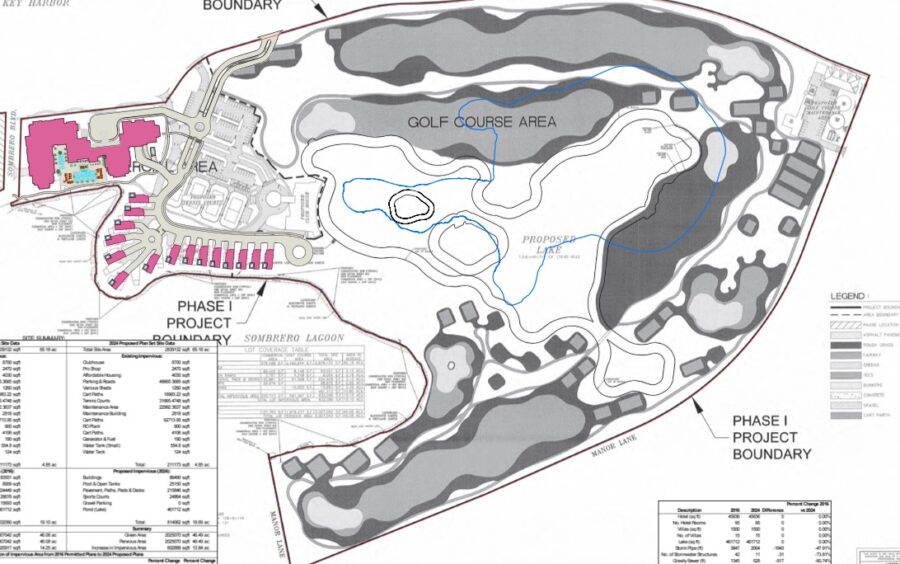
Under the environmental microscope
Resident concerns brought to the Weekly about the resort in the last two months have included allegations of mangrove clearing, over-digging of the lagoon on the property’s eastern end and runoff from newly-placed fill on the eastern “front nine” discoloring water in neighboring canals.
An April 12 notice of noncompliance addressed to Rosasco from the South Florida Water Management District (SFWMD), along with a second notice sent two months later, noted excessive trimming and debris collecting in areas of mangroves along the property’s waterfront, additionally requiring “replanting mangroves that have been destroyed.”
In his July 1 interview, Rosasco acknowledged there are “a couple of things that I need to take care of, which we’re doing right now.”
He said he previously intended to enlarge the on-site lagoon while using removed material to fill other areas of the property, but had since submitted updated plans to the city without the larger lagoon – even after a June 27 email from the SFWMD confirmed that the lagoon’s size could increase without a modified permit.
He attributed the canal discharge to historic recent rainfall in Marathon.
“For whatever reason, a few people here say they want me to do what I’m doing, but (the same people) would prefer to try and stop me. And the way they decided to try and stop me is to create all these rumors and go to every regulatory agency in the state of Florida,” Rosasco said.
Utility line dispute prompts red tag
On June 18, the project was issued a Stop Work Order, later confirmed by both Garrett and Rosasco to stem from the disputed proper placement of a utility line. A subsequent June 27 Notice of Violation noted “several ‘new’ piles of fill that had been placed on the property” on June 25 and 26, indicating continued work on the site after the posting of the Stop Work Order.
Rosasco acknowledged that the Stop Work Order was in response to delays in submitting required engineering drawings to the city, but denied responsibility for the added fill after the red tag.
“I’ve had a continuous problem over the years with people dumping on the site,” he said. “After we shut the project down, a couple of guys came out there with a couple truckloads of asphalt and other stuff. … I’m trying to find out who actually did it, because it’s illegal dumping.”
Residents file cease-and-desist request
Heavily criticized in Marathon’s June 25 city council workshop for its role in escalating flooding issues on Sombrero Boulevard, the development was also named in a request for a cease-and-desist authored by local developer Michael Aranda Jr. and submitted to Williams, Garrett and Planning Director Brian Shea.
Originally filed on June 14 and resubmitted on June 20 to add the signatures of 50 area residents, the request includes allegations of prolonged flooding, destruction of roads and parking lots, negative effects on property values in nearby neighborhoods, and violations of National Pollutant Discharge Elimination System (NPDES) regulations, all of which it said can be traced back to site work for the upcoming resort.
“This project must immediately be red-tagged, issued a cease-and-desist order, and subjected to daily fines until the City inspects the project and determines it is following the applicable permit requirements,” the letter concludes. “This problem exists and will not solve itself – ignoring it is not a viable option. None of the affected communities did anything to deserve this.”
Speaking with the Weekly on July 3, Aranda said the only substantial response he had received from the city was a June 18 email request from third-party claim administration firm PGCS Claims Services requesting a Theory of Liability and Notice of Injury.
“I would like to know the city’s next step, and I would like to see a real solution to a very real problem,” Aranda said by phone. “This project has yet to be held accountable.”

